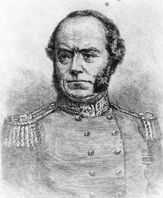The first European in the Maranoa was likely either Thomas Mitchell or his son Roderick in 1846 (though Finney Eldershaw claims he beat both Mitchells by four years in his journey of 1842).
Roderick Mitchell was the deputy Crown Commissioner for Lands in NSW who charted branches of the Balonne River and may have got as far as the Bungil and Bungeworgorai Creeks. His journeys and maps helped his father Sir Thomas Mitchell, surveyor-general of NSW, on his trip to the Maranoa in 1846. Sir Thomas took the same route up the Darling River system into Queensland. He was the first person to describe Mt Abundance and the rich area around it. He called it the Fitz Roy Downs in honour of the Governor of New South Wales, Sir Charles Fitz Roy.
It was no coincidence it was Mitchell followed his son, nor was there a coincidence about the man that followed Sir Thomas to become the first white settler of the Maranoa. His name was Allan Macpherson.

Macpherson’s father William was the clerk of the NSW parliament and a friend of fellow Scot Mitchell. Mitchell was also fond of William’s son Allan, a determined and ambitious young man. Allan was an adventurer who ran cattle and sheep on his Keera property in the remote Gwydir district of northern NSW. While the hilly country reminded him of his native Scotland, it wasn’t profitable. Macpherson was captivated by Mitchell’s description of Mt Abundance as “champaign country” and was determined to claim it for himself.
“First come first served” meant possession under British law, and he set off north-west along the river system for the promised land in July 1847. Macpherson had more than just Mitchell’s maps, he had ten thousand sheep, hundreds of cattle, dozens of horses and drays and twenty men. The going was slow – they travelled just 60km in the first two weeks – but by the end of September his team was at the natural ford or “rocky bar” on the Balonne Mitchell (senior) called St George’s Bridge because he arrived there on the saint’s day, April 23.
St George was the last settled part of the English realm. No white man or woman lived north of the bridge. MacPherson crossed his Rubicon but was forced to halt for the lambing season. Leaving the sheep behind, he finally gazed on Mt Abundance on Friday, October 15, 1847. Macpherson found Mitchell had not exaggerated about the quality of the land. “A glorious prospect!” he enthused.
He claimed a farm 30km wide from the Cogoon River (now Muckadilla Creek) in the west to Bungeworgorai Creek in the east. The sight of the first natives two weeks later scared his men witless. Macpherson shamed them as cowards and spent months building huts, cattle and sheep yards and fencing. Macpherson built several outstations including a cattle station on the spot of what would later become Roma.
The distance to Newcastle was forbidding and Macpherson hoped to find a closer port at Brisbane via the Darling Downs. Urgent farmwork tied him down at Mt Abundance and after Christmas he went back to Keera for more supplies and drays. In January 1848, Macpherson got caught up in a formidable foe: summer floods. Macpherson was bogged in heavy and impassable country with swollen fast-moving creeks.
He eventually made it to Keera but his return to the Maranoa was also delayed by floods. It was again a fleeting visit as Keera and Sydney demanded his presence on urgent family business. It was on his third return to St George’s Bridge, Macpherson received the bad news Mt Abundance had been attacked.
Two men in outstations were speared to death and the rest were fleeing south. Macpherson found them where the Cogoon met the Balonne but could convince only one man to accompany him back to Mt Abundance. The blacks were gone but they left a mess. The experience redoubled his efforts to find a more direct route to the Darling Downs. The furthest he got was to a nearby station east of the Bungil owned by James Alexander Blythe.
Blythe was one of the earliest travellers to the Maranoa after Mitchell and had come back to establish a property between Roma and Wallumbilla. Macpherson was fortunate to survive a skirmish with Aboriginals on his return home after a visit to Blyth but his servant Charley was missing presumed dead.
By the end of 1848, Macpherson became convinced it was too unprofitable to run sheep due to “blacks, losses, native dogs and overcrowding.” He turned Mt Abundance into a cattle property but the native attacks continued and three workers were speared in March 1849. After two more wool-carriers were killed, Macpherson and the new Commissioner of Crown Lands John Durbin patrolled the area with mounted troopers gathering the wool and taking it south. But Macpherson had had enough.
He went off to Scotland to get married and Mt Abundance remained an expensive and unprofitable out station. He sold it on his return “for a song”. As Macpherson said, “it was by no means the first pioneers that reaped the golden returns, but those who were prudent enough to follow in their wake.”

